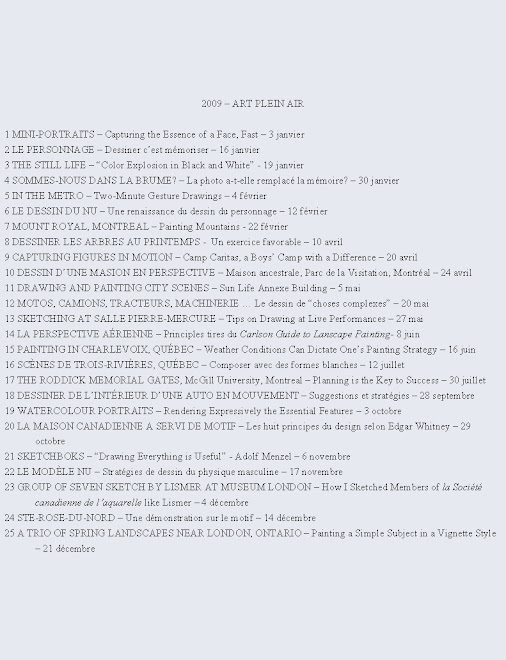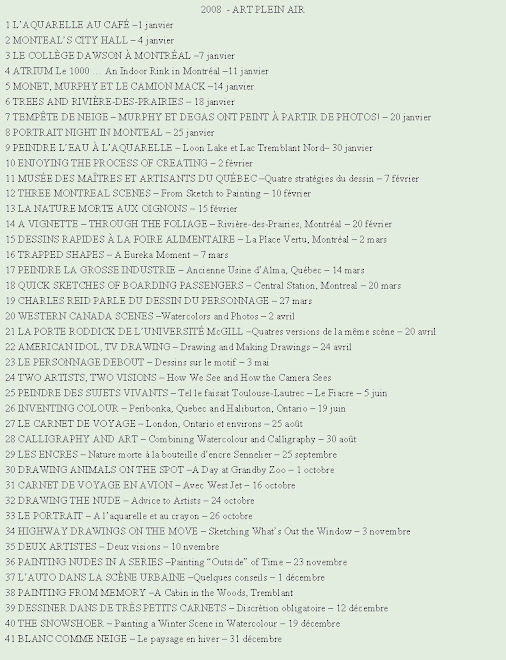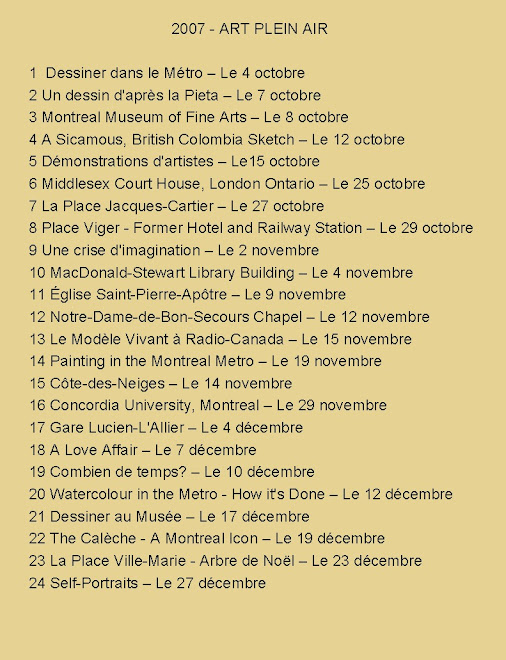
When painting outdoors a change in conditions can occur at any time, even while in the midst of a painting. Because the drying time of watercolor on paper affects greatly its outcome, heat, humidity, and wind must be taken into consideration. Just returning from a painting trip in the Charlevoix, Quebec region, a windy area, I offer these suggestions.

On a windy day
If I am painting in windy conditions I will paint the sky in the studio later especially if it is a major area of the painting. In the wind a large wash will often dry unevenly and sometimes create back runs. Pigment and water may puddle and drip, blown by the wind. Sometimes these effects are favorable, sometimes not.
Painting in direct sunlight
The best viewpoint is sometimes in direct sunlight. However, direct sunlight reflecting off the paper will warm the fibers often causing washes and paint strokes to dry very quickly. The blending effect of watercolor, so sought after, does not have time to occur. Therefore, try to lay in the color washes in small areas. Counteract a fast drying time by overloading your brush with a good supply of both pigment and water.

On a humid cloudy day
The ideal time to paint a multi-colored variable sky is on an overcast humid day. Or opt for a scene where there are large areas of varied color running into each other. You should have time to blend wet in wet. Painting a larger format painting would also be a good choice. Using reference photos, one could then finish the larger painting in the studio.
The ideal: Out of the wind and in the shade
The ideal is to stay out of the wind and to find a shady corner. Paint sitting low and use a small format – your body should cast enough shade and wind break on your sheet. Seek shelter beside a tree, your car, a house or any other structure. Although your location might not be the best viewpoint, sketch the bones of the scene in the sunlight or wind and then complete the painting nearby in the shade and shelter from memory. Often these are the most successful paintings because one has to work intuitively.

Painting under an umbrella
The disadvantage of painting under a standard lightweight lawn umbrella is that most are colored and the tint might influence, distract or alter desired colors. However, if you can ignore or deal with this, any umbrella is better than no umbrella especially on a very sunny day. I use a heavy doubled layered black/gray canvas umbrella equipped with tie down ropes much like a tent. Unfortunately, some tell me this painter’s umbrella is difficult to find.
Painting with sunglasses
I never recommend painting watercolor in direct sunlight to my students but if it cannot be avoided I suggest you wear sunglasses as the reflection off the white paper can be blinding. I have found that one adapts quickly to the change of the tint of the shades and the slightly altered coloration.

The one hour rule
In my opinion, one should not paint an outdoor scene for longer than an hour. Not only will the lighting have changed but your energy and concentration will have waned. It is time to take a break even if it means coming back another day on the same spot.
I feel there is nothing that beats working on site to capture the feel and emotion of a scene.
Raynald Murphy sca

On a windy day
If I am painting in windy conditions I will paint the sky in the studio later especially if it is a major area of the painting. In the wind a large wash will often dry unevenly and sometimes create back runs. Pigment and water may puddle and drip, blown by the wind. Sometimes these effects are favorable, sometimes not.
Painting in direct sunlight
The best viewpoint is sometimes in direct sunlight. However, direct sunlight reflecting off the paper will warm the fibers often causing washes and paint strokes to dry very quickly. The blending effect of watercolor, so sought after, does not have time to occur. Therefore, try to lay in the color washes in small areas. Counteract a fast drying time by overloading your brush with a good supply of both pigment and water.

On a humid cloudy day
The ideal time to paint a multi-colored variable sky is on an overcast humid day. Or opt for a scene where there are large areas of varied color running into each other. You should have time to blend wet in wet. Painting a larger format painting would also be a good choice. Using reference photos, one could then finish the larger painting in the studio.
The ideal: Out of the wind and in the shade
The ideal is to stay out of the wind and to find a shady corner. Paint sitting low and use a small format – your body should cast enough shade and wind break on your sheet. Seek shelter beside a tree, your car, a house or any other structure. Although your location might not be the best viewpoint, sketch the bones of the scene in the sunlight or wind and then complete the painting nearby in the shade and shelter from memory. Often these are the most successful paintings because one has to work intuitively.

Painting under an umbrella
The disadvantage of painting under a standard lightweight lawn umbrella is that most are colored and the tint might influence, distract or alter desired colors. However, if you can ignore or deal with this, any umbrella is better than no umbrella especially on a very sunny day. I use a heavy doubled layered black/gray canvas umbrella equipped with tie down ropes much like a tent. Unfortunately, some tell me this painter’s umbrella is difficult to find.
Painting with sunglasses
I never recommend painting watercolor in direct sunlight to my students but if it cannot be avoided I suggest you wear sunglasses as the reflection off the white paper can be blinding. I have found that one adapts quickly to the change of the tint of the shades and the slightly altered coloration.

The one hour rule
In my opinion, one should not paint an outdoor scene for longer than an hour. Not only will the lighting have changed but your energy and concentration will have waned. It is time to take a break even if it means coming back another day on the same spot.
I feel there is nothing that beats working on site to capture the feel and emotion of a scene.
Raynald Murphy sca








